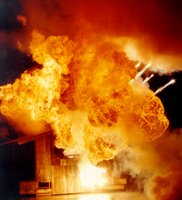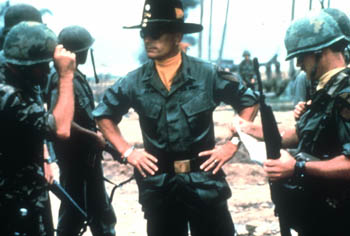
There are about 20 or so military fighter jet performance teams besides the Thunderbirds and Blue Angels. I find it interesting to compare the airplanes each group chooses to fly. Except for the Americans and the Russians, all other teams fly trainer aircraft, not front line, top performance fighters. (I could be wrong on this, but that's how it looks to me.)
The Thunderbirds fly the Lockheed Martin F-16 Fighting Falcon. According to the Air Force, the F-16 is a "highly maneuverable multi-role fighter proven to be one of the world's best precision tactical bombers and air-to-air combat aircraft. The only modifications needed to prepare the aircraft for its air demonstration role are installing a smoke-generating system in the space normally reserved for the 20mm cannon, and the painting of the aircraft in Thunderbird colors."
The Russian equivilent to the Thunderbirds are the "Russian Knights." The RK fly the incredibly huge Su-27 flanker fighter jet. It's a much larger aircraft than the F-16, which makes it a difficult airplane (so I'm told) to use as a close quarters demonstration aircraft.

SU-27 Specifications
Takeoff weight: 51,015 lb
Powerplant: two Saturn/ Lyul'ka AL-31F afterburning turbofans
Thrust: 55,116 lb
Max Speed : Mach 2.35
F-16 Specification
Takeoff weight: 23,765lb
Powerplant: one Pratt & Whitney F100-220 afterburning turbofan
Thrust: 29,100 lb
Max Speed : Mach 2.0
I don't know if the Thunderbirds and the Knights ever fly at the same airshow. It would be a cool thing to watch and compare - the manueverable F-16 versus the huge, fast Su-27.
By the way, on March 25-26, in the skies over Fort Smith, Ark., Nicole Malachowski made aviation history when the Air Force Thunderbirds gave their first performance of the 2006 season. Malachowski is the first female pilot ever selected for either the Thunderbirds or the Navy's Blue Angels.










































